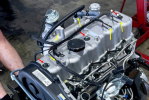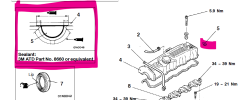DeliKit
Active Member
The van did so well for our whole long cross-country trip, right up until the last 4 hours!
Here are the symptoms, and they're serious I think. Note that we traveled 6,910 km in total over a couple of weeks, and traversed many hills, while towing a relatively light trailer (about 500 pounds total loaded?) The hardest hills were nearer the beginning, and the van did so well going uphill in third over the Rockies, heading east!
So everything's been great, other than cold starts, but we worked those out and had no other problems until we were somewhere in Connecticut, going uphill in third as usual, and I could have sworn I saw a great puff of grayish smoke out the back. Then I saw it again, clearly it seemed, a large cloud. I pulled off, everything seemed alright, and note that the van had been going uphill just as normal, same amount of power it seemed. So I pulled back on the highway, since we were nowhere near a town, and then sadly I saw another grayish cloud again while I was accelerating up to highway speed.
Then it seemed like everything was normal, and I was worried about continuing to drive, but I had my daughter and cat and all our things with us, and we were within hours of our final destination. I started to wonder if perhaps I imagined the smoke somehow with the lighting, as I didn't see it again for awhile? But I was nervous for sure.
I stopped for fuel, and it didn't start quite as usual, even though it was warm. It faltered, the engine, and the idle seemed a bit low. I knew I'd have one more fuel stop to make too, before I reached where we were going. I continued on! I started to see the smoke up every hill when in third though, and I worried more. Though strangely, it wasn't always blowing out smoke in third uphill, but more often than not it was, then it would seem to clear up (though it was getting dark now, so becoming harder to see unless it was illuminated by headlights behind me).
Note that I knew I was overdue for an oil change too, but I'd lost track of my last oil filter, even though we had oil with us. I thought we'd be alright going an extra thousand miles too, since the oil change would still be changed at 4000ish (this is usual non-synthetic oil).
At the last fuel stop, I knew something was seriously wrong. I started up the van after fueling up, and a cloud of gray smelly exhaust was emitted, which has never happened before with the new D4BF engine (which may well still be in its break-in period, though I'd done 1000 miles since it was put in, before this cross-country trip). Again, for almost our whole trip, it'd been purring along. But I heard a roughness now in the engine... it was louder than it should be.
I kept going, as we were like two hours away by then, and it was nighttime, and it seemed so important to make it if we could. The van drove just fine, other than sounding rough (it cruised alright, but sounded rough at low speeds and getting up to speed). When I arrived, I parked it, then had to do a cold start the next morning to put it in 4WD and find my way up this driveway here, which was rough terrain. It sounded terrible when it started, and emitted great clouds of gray-blue smoke. I went and sniffed the smoke, and it definitely wasn't sweet (a relief!), it smelled like straight-up diesel exhaust from big trucks.
From what I've read here, I'm afraid it's the turbo (which was new with the D4BF... and how would I have messed it up on easy Connecticut hills, after it was fine through so many others?). It seems we may even have risked something serious, "diesel runaway"? Oh, and I checked the oil at our last stop, and since I'd been afraid to turn the engine off, I pulled the dipstick with it running (thinking that was alright?) and I saw smoke coming out of the hole for the dipstick, and it smelled wrong. I turned it off and tried the dipstick again just after the engine was off, and then I didn't see smoke, but it seems maybe an important detail?
It didn't seem low on oil, but the oil looked kind of like it was behaving different on the dipstick. It smelled "cooked" somehow? I checked our mileage, and it was 18.3 miles per gallon, which is right up there with our best mileage on this trip (we averaged around 16.5 m/g I think). And again, there was no loss of power up hills. But it sounds and smells wrong for sure, and I know that it needs some care before I try driving it anywhere again.
My poor little van! I'm going to attach some videos to this post next, once I upload them over this rural slow internet I have here! Clearly I should change the oil too. I'm also very far from any known mechanics now, down a dirt road in a forest in Massachusetts. At least I have help here, at least someone who's capable of physically turning wrenches (I often struggle, even when I know what to do!)
Here are the symptoms, and they're serious I think. Note that we traveled 6,910 km in total over a couple of weeks, and traversed many hills, while towing a relatively light trailer (about 500 pounds total loaded?) The hardest hills were nearer the beginning, and the van did so well going uphill in third over the Rockies, heading east!
So everything's been great, other than cold starts, but we worked those out and had no other problems until we were somewhere in Connecticut, going uphill in third as usual, and I could have sworn I saw a great puff of grayish smoke out the back. Then I saw it again, clearly it seemed, a large cloud. I pulled off, everything seemed alright, and note that the van had been going uphill just as normal, same amount of power it seemed. So I pulled back on the highway, since we were nowhere near a town, and then sadly I saw another grayish cloud again while I was accelerating up to highway speed.
Then it seemed like everything was normal, and I was worried about continuing to drive, but I had my daughter and cat and all our things with us, and we were within hours of our final destination. I started to wonder if perhaps I imagined the smoke somehow with the lighting, as I didn't see it again for awhile? But I was nervous for sure.
I stopped for fuel, and it didn't start quite as usual, even though it was warm. It faltered, the engine, and the idle seemed a bit low. I knew I'd have one more fuel stop to make too, before I reached where we were going. I continued on! I started to see the smoke up every hill when in third though, and I worried more. Though strangely, it wasn't always blowing out smoke in third uphill, but more often than not it was, then it would seem to clear up (though it was getting dark now, so becoming harder to see unless it was illuminated by headlights behind me).
Note that I knew I was overdue for an oil change too, but I'd lost track of my last oil filter, even though we had oil with us. I thought we'd be alright going an extra thousand miles too, since the oil change would still be changed at 4000ish (this is usual non-synthetic oil).
At the last fuel stop, I knew something was seriously wrong. I started up the van after fueling up, and a cloud of gray smelly exhaust was emitted, which has never happened before with the new D4BF engine (which may well still be in its break-in period, though I'd done 1000 miles since it was put in, before this cross-country trip). Again, for almost our whole trip, it'd been purring along. But I heard a roughness now in the engine... it was louder than it should be.
I kept going, as we were like two hours away by then, and it was nighttime, and it seemed so important to make it if we could. The van drove just fine, other than sounding rough (it cruised alright, but sounded rough at low speeds and getting up to speed). When I arrived, I parked it, then had to do a cold start the next morning to put it in 4WD and find my way up this driveway here, which was rough terrain. It sounded terrible when it started, and emitted great clouds of gray-blue smoke. I went and sniffed the smoke, and it definitely wasn't sweet (a relief!), it smelled like straight-up diesel exhaust from big trucks.
From what I've read here, I'm afraid it's the turbo (which was new with the D4BF... and how would I have messed it up on easy Connecticut hills, after it was fine through so many others?). It seems we may even have risked something serious, "diesel runaway"? Oh, and I checked the oil at our last stop, and since I'd been afraid to turn the engine off, I pulled the dipstick with it running (thinking that was alright?) and I saw smoke coming out of the hole for the dipstick, and it smelled wrong. I turned it off and tried the dipstick again just after the engine was off, and then I didn't see smoke, but it seems maybe an important detail?
It didn't seem low on oil, but the oil looked kind of like it was behaving different on the dipstick. It smelled "cooked" somehow? I checked our mileage, and it was 18.3 miles per gallon, which is right up there with our best mileage on this trip (we averaged around 16.5 m/g I think). And again, there was no loss of power up hills. But it sounds and smells wrong for sure, and I know that it needs some care before I try driving it anywhere again.
My poor little van! I'm going to attach some videos to this post next, once I upload them over this rural slow internet I have here! Clearly I should change the oil too. I'm also very far from any known mechanics now, down a dirt road in a forest in Massachusetts. At least I have help here, at least someone who's capable of physically turning wrenches (I often struggle, even when I know what to do!)




